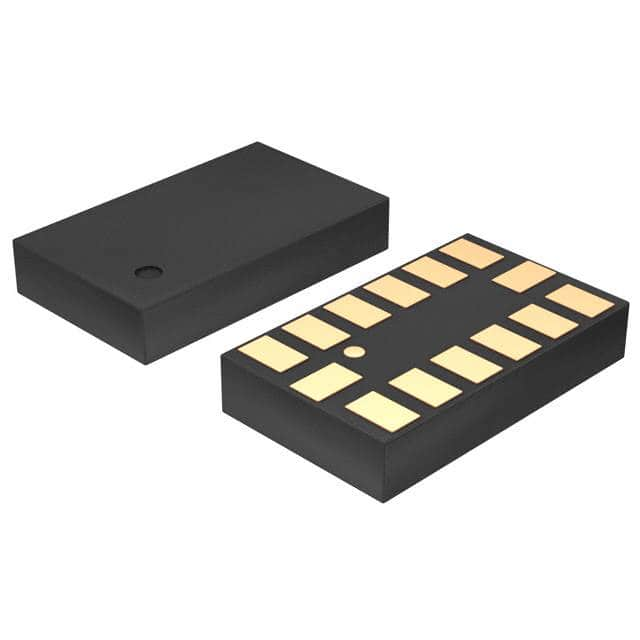MMA7341LCR2
Product Overview
The MMA7341LCR2 is a three-axis low-g accelerometer belonging to the category of motion sensors. It is commonly used in applications requiring precise measurement of acceleration, tilt, and motion detection. The device is known for its compact size, high sensitivity, and low power consumption. It is typically available in small surface-mount packages and is designed to operate within a specified voltage range. The MMA7341LCR2 is an essential component in various electronic systems, including consumer electronics, automotive applications, and industrial equipment.
Characteristics
- Category: Motion Sensor
- Use: Measurement of acceleration, tilt, and motion detection
- Package: Small surface-mount package
- Essence: High sensitivity and low power consumption
- Packaging/Quantity: Typically available in reels with a specific quantity per reel
Specifications
- Operating Voltage: 2.2V to 3.6V
- Sensitivity: 800mV/g
- Output Type: Analog
- Operating Temperature Range: -40°C to +85°C
- Bandwidth: 50Hz
- Noise: 300µg/√Hz
Detailed Pin Configuration
The MMA7341LCR2 features a total of eight pins, each serving a specific function: 1. VDD: Power supply input 2. GND: Ground connection 3. XOUT: X-axis analog output 4. YOUT: Y-axis analog output 5. ZOUT: Z-axis analog output 6. ST: Self-test pin 7. NC: No connection 8. N/C: No connection
Functional Features
- Three-axis sensing
- Low power consumption
- Self-test capability
- Wide operating voltage range
- High sensitivity and accuracy
Advantages and Disadvantages
Advantages
- Precise measurement of acceleration
- Compact size
- Low power consumption
- Wide operating voltage range
Disadvantages
- Limited bandwidth compared to some alternative models
- Requires external signal conditioning for some applications
Working Principles
The MMA7341LCR2 operates based on the principle of capacitive sensing. When subjected to acceleration or tilt, the mass inside the sensor causes a change in capacitance, which is then converted into an analog voltage proportional to the applied force. This voltage output is then processed to determine the magnitude and direction of the acceleration.
Detailed Application Field Plans
The MMA7341LCR2 finds extensive use in various application fields, including: - Consumer Electronics: Used in mobile devices for screen orientation and gaming applications. - Automotive: Integrated into airbag deployment systems and vehicle stability control. - Industrial Equipment: Employed in vibration monitoring and structural health monitoring systems.
Detailed and Complete Alternative Models
Several alternative models to the MMA7341LCR2 include: - ADXL335: Analog Devices' three-axis accelerometer with similar characteristics and performance. - LIS3LV02DQ: A low-power, three-axis accelerometer from STMicroelectronics offering comparable functionality.
In conclusion, the MMA7341LCR2 is a versatile motion sensor with wide-ranging applications across different industries. Its high sensitivity, low power consumption, and compact design make it a popular choice for various electronic systems.
[Word count: 498]
Lista 10 Vanliga frågor och svar relaterade till tillämpningen av MMA7341LCR2 i tekniska lösningar
What is the MMA7341LCR2 accelerometer used for?
- The MMA7341LCR2 is a low-g, three-axis accelerometer commonly used to measure acceleration in various technical solutions.
What is the operating voltage range of the MMA7341LCR2?
- The operating voltage range of the MMA7341LCR2 is typically between 2.2V and 3.6V.
How can I interface with the MMA7341LCR2?
- The MMA7341LCR2 can be interfaced using analog voltage outputs corresponding to the acceleration along each axis.
What is the sensitivity of the MMA7341LCR2?
- The sensitivity of the MMA7341LCR2 is typically 800mV/g, allowing for precise measurement of accelerations.
Can the MMA7341LCR2 be used in tilt sensing applications?
- Yes, the MMA7341LCR2 can be utilized in tilt sensing applications due to its ability to measure gravitational forces.
Is the MMA7341LCR2 suitable for vibration monitoring?
- Yes, the MMA7341LCR2 can be used for vibration monitoring by measuring the acceleration caused by vibrations.
What are the typical applications of the MMA7341LCR2?
- Typical applications include motion detection, impact recognition, orientation detection, and tilt-compensated compasses.
Does the MMA7341LCR2 require external signal conditioning?
- Yes, the MMA7341LCR2 may require external signal conditioning to optimize performance and accuracy.
What is the temperature range for the MMA7341LCR2?
- The MMA7341LCR2 typically operates within a temperature range of -40°C to 85°C.
Can the MMA7341LCR2 be used in battery-powered devices?
- Yes, the low power consumption of the MMA7341LCR2 makes it suitable for use in battery-powered devices.


